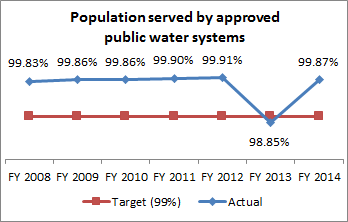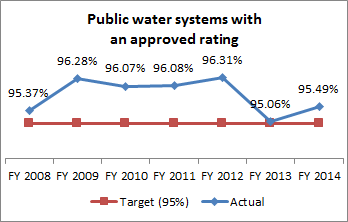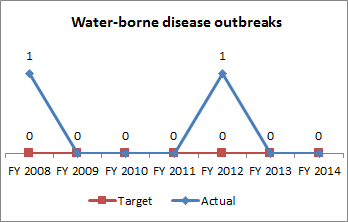The Division of Drinking Water cooperatively works with drinking water professionals and the public to ensure a safe and reliable supply of drinking water.
During the 2015 General Session, the Legislature appropriated for Fiscal Year 2016, $4,924,100 from all sources for Drinking Water. This is a 9 percent reduction from Fiscal Year 2015 revised estimated amounts from all sources. The total includes $1,101,100 from the General/Education Funds, an increase of 2.8 percent from revised Fiscal Year 2015 estimates.
Population with Safe Drinking Water
Approved public water systems are those that are in substantial compliance with all the division's rules. This measure indicates the percentage of the population that is provided a safe and reliable supply of drinking water. The numbers vary slightly from year to year. If large or very large water systems had non-compliance problems, the numbers would differ significantly.

Public Water Systems with Approved Rating
This measure indicates the percentage of public drinking water systems with an approved rating. This measure tracks the changes amongst small and very small systems; these systems make up over 75% of the public water systems in the state.

Water-borne Disease Outbreaks
This measure is a count of all water-borne disease outbreaks in the state. The 2012 was at Cedar Hills.

Other Drinking Water Performance Measures
In addition to the key performance measures listed above, the division reported the following performances measures for FY 2014:
- regulated approximately 1,021 public water systems, ensuring that 99.87 percent of the population in Utah gets water from an approved public water system;
- conducted 318 sanitary surveys;
- reviewed 328 unique engineering projects and provided a total of 904 responses;
- reviewed 415 source protection plans;
- took 15 formal enforcement actions;
- authorized 11 construction projects involving $16,413,000 in financial assistance; and,
- maintained certifications for 2,252 water system operators.
Note
Note: Engineering responses include responses to: a) unique engineering projects, b) plan review waiver requests, c) exceptions to the design and construction rules, d) corrections of physical deficiencies discovered during site visits, e) capacity evaluations (financial, technical and managerial capacity), f) groundwater sources reviewed to determine if they are being influenced by surface water, g) well grout witnessing and h) issuance of Operating Permits.
Its major functions include the following:
- provide technical assistance to drinking water systems and consultants;
- provide oversight and compliance assistance for water treatment plants;
- review/approve construction plans and issue operating permits;
- manage cross connection control program;
- manage construction loan program;
- administer drinking water source protection program;
- ensure compliance with Utah public drinking water monitoring and quality rules;
- manage Operator Certification Program;
- train and communicate with public and water system personnel on new rules;
- write and implement all rules and requirements from EPA;
- coordinate with the Divisions of Public Utilities, Water Quality, Water Resources and Water Rights;
- track drinking water systems that meet requirements of the Safe Drinking Water Act; and,
- perform site inspections (sanitary surveys) and track the correction of physical deficiencies.
There are five sections within this division, each of which is described below:
Administrative Services Section
This section provides support services to the division in the areas of budgeting, purchasing, contracting, grants management and personnel. The section also administers the Drinking Water Source Protection Program.
Engineering Section
This section establishes the design and construction standards for drinking water facilities, performs plan reviews for construction of water facilities throughout Utah and issues operating permits for those projects. It performs grout witness services on new wells as well as construction inspections. It provides technical assistance to public drinking water systems to resolve physical and capacity deficiencies. It provides construction inspections. It also performs site inspections known as sanitary surveys.
Field Services Section
This section administers the Operator Certification program and the Backflow Technician program. Field Services takes the lead in emergency response and directs the performance of sanitary surveys.
Rules Section
This section deals with the ongoing operations of drinking water systems by providing technical assistance and implementing the federal rules. This section oversees the operation of 469 community water systems, 69 non-transient non-community water systems, and 480 non-community water systems. It also performs sanitary surveys.
Construction Assistance Section
This section administers the state and federal loan programs. For those projects that receive financial assistance, this section also reviews plans and performs construction inspections.
Funding for FY 16 drinking water loans is expected to be $21,907,500:
- $3,587,500 - designated sales tax;
- $6,000,000 - federal funds; and,
- $12,320,000 - loan repayments (principal, interest, and fees).
COBI contains unaudited data as presented to the Legislature by state agencies at the time of publication. For audited financial data see the State of Utah's Comprehensive Annual Financial Reports.